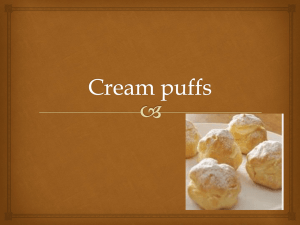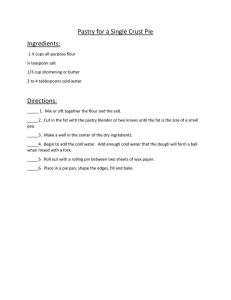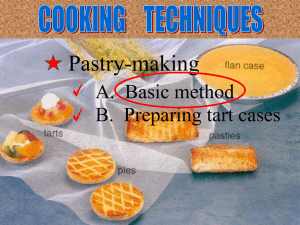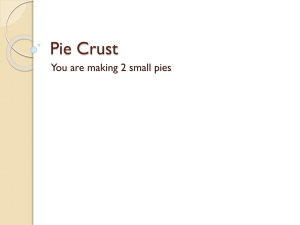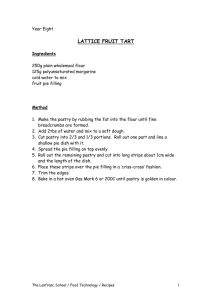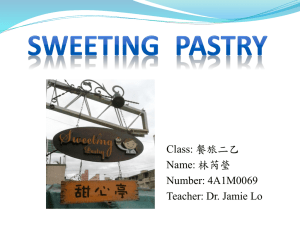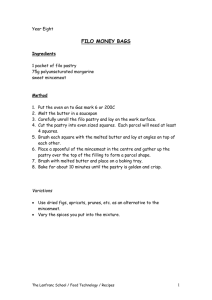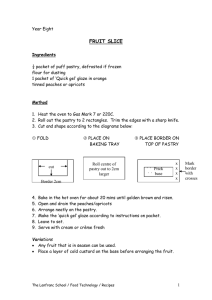TLEBPP10 Q2 Mod4 -Mixing-Techniques-Procedures-and-Types-of-Pastries v3-converted
advertisement
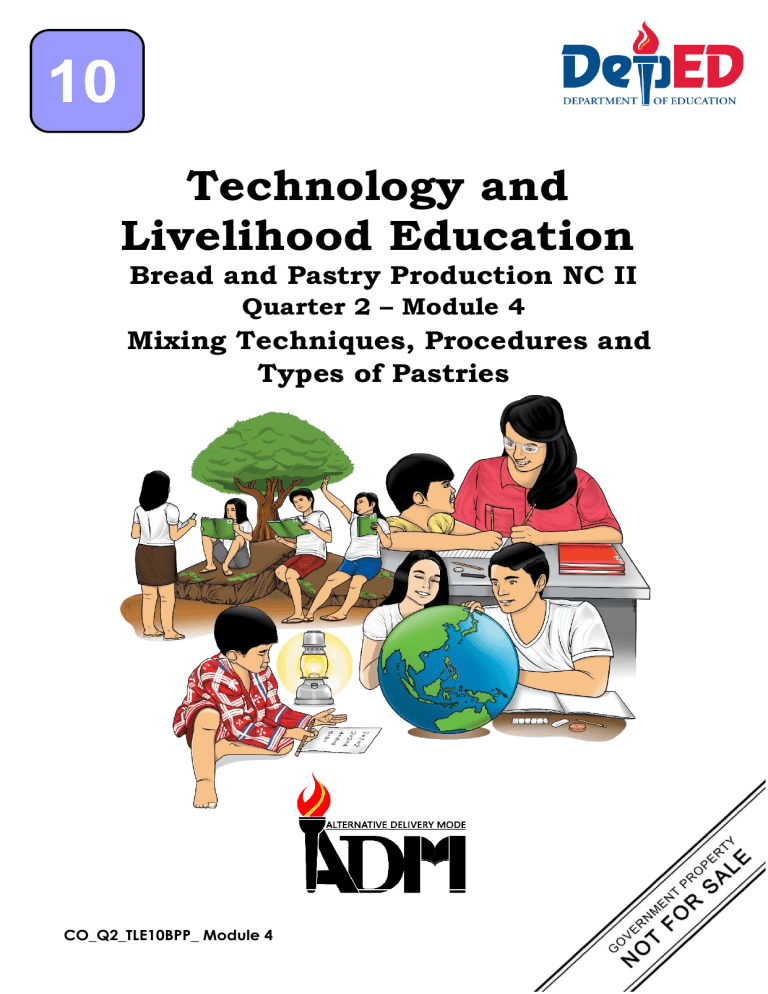
10 10 Technology and Livelihood Education Bread and Pastry Production NC II Quarter 2 – Module 4 Mixing Techniques, Procedures and Types of Pastries CO_Q2_TLE10BPP_ Module 4 TLE – Grade 10 Alternative Delivery Mode Quarter 2 – Module 4: Bread and Pastry Production Mixing Techniques, Procedures and Types of Pastries First Edition, 2020 Republic Act 8293, section 176 states that: No copyright shall subsist in any work of the Government of the Philippines. However, prior approval of the government agency or office wherein the work is created shall be necessary for exploitation of such work for profit. Such agency or office may, among other things, impose as a condition the payment of royalties. Borrowed materials (i.e., songs, stories, poems, pictures, photos, brand names, trademarks, etc.) included in this module are owned by their respective copyright holders. Every effort has been exerted to locate and seek permission to use these materials from their respective copyright owners. The publisher and authors do not represent nor claim ownership over them. Published by the Department of Education Secretary: Leonor Magtolis Briones Undersecretary: Diosdado M. San Antonio Development Team of the Module Writers: Merlie C. Mangannay Editors: Jonalyn Ambrona Reviewers: Primo B. Aligo Illustrator: Layout Artist: Neil Edward D. Diaz Management Team: Estela Leon-Cariño Rosita C. Agnasi Georgina C. Ducayso Khad M. Layag Jocelyn P. Samidan Dolores M. Anecang Atkinson F. Tudlong Printed in the Philippines by ________________________ Department of Education – Region CAR Office Address: Wangal, La Trinidad, Benguet Telefax: (074)-422-4074 E-mail Address: car@deped.gov.ph 10 Technology and Livelihood Education Bread and Pastry Production NC II Quarter 2 – Module 4 Mixing Techniques, Procedures and Types of Pastries Introductory Message This Self-Learning Module (SLM) is prepared so that you, our dear learners, can continue your studies and learn while at home. Activities, questions, directions, exercises, and discussions are carefully stated for you to understand each lesson. Each SLM is composed of different parts. Each part shall guide you step-by-step as you discover and understand the lesson prepared for you. Pre-tests are provided to measure your prior knowledge on lessons in each SLM. This will tell you if you need to proceed on completing this module or if you need to ask your facilitator or your teacher’s assistance for better understanding of the lesson. At the end of each module, you need to answer the post-test to self-check your learning. Answer keys are provided for each activity and test. We trust that you will be honest in using these. In addition to the material in the main text, Notes to the Teacher are also provided to our facilitators and parents for strategies and reminders on how they can best help you on your home-based learning. Please use this module with care. Do not put unnecessary marks on any part of this SLM. Use a separate sheet of paper in answering the exercises and tests. And read the instructions carefully before performing each task. If you have any questions in using this SLM or any difficulty in answering the tasks in this module, do not hesitate to consult your teacher or facilitator. Thank you. What I Need to Know This module was designed and written with you in mind. It is here to help you master the concepts of bread and pastry production. The scope of this module permits it to be used in many different learning situations. The language used recognizes your vocabulary level. The lessons are arranged to follow the standard sequence of the course. But the order in which you read them can be changed to correspond with the textbook you are now using. This module provides you the necessary information and activities to enrich your knowledge and skills in preparing and presenting breads. Lesson 4 – Mixing Techniques and Procedures of Different Types of Pastries After going through this module, you are expected to: 1. identify mixing techniques in preparing different types of pastries 2. explain the mixing procedures of different pastry products 3. understand the importance of knowing the different mixing procedures of pastries What I Know Multiple Choice: Direction: Choose the letter of the best answer. Write the letter of your answer in a separate sheet of paper. 1. What is the simplest method in mixing the ingredients together with utensils, usually a spoon, using circular motion? a. Beating c. Folding b. Creaming d. Stirring 2. Which kind of pastry prepares a beurre manie and laminates it with the pastry dough? a. Choux Pastry c. Puff Pastry b. Flaky Pastry d. Short crust Pastry 3. What is the outer part of the pastry? a. Crust c. Muffins b. Filling d. Topping 4. The process of enclosing butter into pastry dough and rolling it into rectangular shape is a. Folding c. Non-laminating b. Laminating d. Rolling 1 5. What is the process of rubbing one or two ingredients against a bowl with the tip of a wooden spoon or electric mixer? a. Beating c. Folding b. Creaming d. Stirring 6. Dipping your fingers into the flour and gently rubbing the little pieces of butter into the flour is a. Creaming c. Pressing b. Cutting d. Rubbing 7. When eggs are first added to the choux pastry, the dough will seem ________________. a. Gloppy and slimy c. Watery and glossy b. Glossy and dry d. Watery and slippery 8. In making pastry dough of choux pastry salt, butter and water is heat over medium fire until it reaches _________________. a. Boiling point c. Hot temperature b. Cooking time d. Nearly to boil 9. Which mixing techniques in baking usually used for meringue and for chiffon products? a. Blending c. Kneading b. Folding d. Whisking 10. Which factor does not affect gluten development? a. Amount of sugar added b. Amount of water added c. Controlled manipulation d. Ratio of flour to shortening 11. The strokes to use when mixing pastry dough should be a. Heavy c. Moderate b. Light d. Very light 12. Which is added to the flour mixture before kneading to produce a soft and satiny dough in making Filo pastry? a. Cold butter c. Hot milk b. Cold water d. Hot oil 13. What is the first step in making a hot water short crust pastry? a. Creaming the butter and the flour. b. Heating the water and the fat until it boils. c. Making the beurre manie. d. Rubbing the butter into the flour. 2 14. You need to _______________ the crust before putting in the filling a. Brush with egg wash c. Prick with fork b. Dust with flour d. Sprinkle with oil 15. What are you going to do if you decide to use your pastry dough the following day? a. Brush with oil and wrap. b. Prebake the dough. c. Store in a closed container. d. Wrap with cling wrap and put inside the fridge. Lesson 4 Mixing Techniques, Procedures and Types of Pastries What’s In Different types of pastry have different mixing procedures to attain the desired texture and good quality of the product. Working with the different pastry is an exciting job because it helps you identify which pastry suits the customer’s taste; thus you have to consider also what filings suits your pastry. Before we continue with our discussion you have to answer first the activity given below. Directions: Using the knowledge that you have learned about pastries, fill in the concept map below by indicating the different kinds of pastries and their characteristics. Copy the concept map in your TLE notebook and write your answer. 3 Notes to the Leaner Prior to understanding the lesson on the mixing techniques and procedures of different types of pastry you are given a brief background on how to mix the different pastries in your recipe. You should be able to discern the importance of mixing techniques and mixing procedures to come up with a good quality of baked pastries. What’s New Loop a Word. Directions: Find the words related to the different mixing techniques and procedure in pastry making and write it on a separate sheet of paper. A B W H I S K I N G J K L M N D C D C D A E N K S R Q P O W R L A M I N A T E R S R D Y H F D T D A B D B D F T U L Z I C C I E B L L C O R U B O K P S E R R C C F D G G V B F N P T F A E D S I E V E T I Q B I 4 I G B G A D G F G H E N R A N R H C I E M H N H L F G S K G R B O I L E I G K I G L T E F I I A A F T J N J N H M U F V N J B T A F I H G I I N V G B G K C E E R K I K T J O W H N A L B B P G L J L U K P X K M B O B S G S M K B C L W R A P What Is It Mixing Techniques Applied for Pies and Pastries 1. Stirring - mixing all ingredients together usually with a spoon in a circular motion. 2. Beating – introducing air into the mixture through mechanical agitation as in beating eggs. An electric mixer is often used to beat the ingredients together. 3. Whisking – also known as the whipping method and is usually used for meringue, and for chiffon products. Air is incorporated into such food as whipping cream and egg whites through very vigorous mixing, usually with an electric mixer or whisk. 4. Laminating - fat is repeatedly folded into the dough. 5. Creaming – fat and sugar are beaten together until light airy texture. 6. Kneading - working with the dough using the heel of hands, accompanied by pressing, stretching and folding in order to develop its gluten. 7. Cut in or cutting in – cutting fat into smaller pieces using two knives or pastry blender to distribute fat in flour until it resembles into coarse. Mixing Procedures of Different Types of Pastry 5 1. Short Crust Pastry https://tinyurl.com/yaf4akkh 2. Cut the cold butter into small pieces then stir it into the flour using a knife. 1. Sieve the flour and salt into a large mixing bowl, holding the sieve high above the bowl so the flour gets a good airing. 3. Rub the fat into the flour – dip your fingertips into the flour and gently rub the little pieces of butter between the tips of your thumbs and fingers so that they flatten and gradually mix into to flour. https://tinyurl.com/y7bxzueg https://tinyurl.com/y9hze2w4 4. Keep rubbing in as lightly as you can until you cannot see any more bits of butter and the mixture looks like coarse breadcrumbs. Try to do the rubbing in as quickly as possible as the longer you are touching the butter the hotter it will become and your mixture may become greasy and sticky. 5. Sprinkle 1 tablespoon of cold water over the mixture and quickly mix it in with the knife. If there are any dry bits of flour in the bottom of the bowl sprinkle over a tiny bit more water and mix again. https://tinyurl.com/yc34zcd2 https://tinyurl.com/y8hestlb 6 6. Use your hand to bring the pastry together in a ball, this is easiest if you use a wiping motion and wipe all the little bits up into one big ball. The dough should feel like plasticine neither too hard nor too soft. 7.Flour your hands and the rolling pin. Pat the dough down a little so the surface is flat. you in gentle 9. Keep rolling until the pastry is the required thickness – roll over a rolling pin then unroll it over the pie pan to fit. 8.Use the rolling pin to roll the pastry away from strokes, pressing down with it gently as you go. https://tinyurl.com/yb7zkmc6 https://tinyurl.com/y8dw36r7 2. Puff Pastry 1. Prepare BEURRE MANIÉ: rub butter with your fingertips, and then add the flour in one addition. Rub in together butter and flour until smooth dough. Shape into a thick, compact square. Wrap into cling film and place in the refrigerator. https://tinyurl.com/y99so7ns 1. PUFF PASTRY: mix the flour with the salt, then turn out onto your work surface in a pile. Run your fingers down the center to create a trough. Sprinkle 1 tablespoon of water into the trough. Quickly fluff the dough with your fingers, keeping your fingers loose and using a scooping motion. Gather the flour back in to a mound, create a trough, and add another tablespoon of water. Continue sprinkling and fluffing until the flour clumps together in large pieces and holds together when pressed. 7 https://tinyurl.com/y99so7ns 2. Shape the dough into a cross with 4 arms, keeping the center part a little bit fluffy. Roll out each arm toward the outside, using a rolling pin. Place the beurre meunié in the center, and then fold each arm of the dough over the butter so they meet in the middle. With the last arm, make sure to cover all over, including the sides. https://tinyurl.com/y99so7ns 3. For the 1st turn: using a rolling pin, gently shape into a long rectangle 12 inches by 6 inches (30,5 X 15 cm), tapping the dough rather than rolling it, so that you spread the butter from inside without piercing the dough. Fold the top third over the bottom third, and the bottom over the top third, likes a letter. The first tour is done. https://tinyurl.com/y99so7ns 8 4. For the other turns: rotate the folded dough so it looks like a book about to be opened. Roll it out again into a rectangle 12 inches by 6 inches. Fold it again. Make 6 turns in total. My advice: start with 3 tours, and then wrap the dough into cling film and place in the refrigerator. Remove a few hours later, ideally the day after, and make the 3 remaining turns https://tinyurl.com/y99so7ns 3. Filo Pastry 1. In a bowl add flour, make a well at the center, add baking powder, salt, melted butter, and vinegar, use the hot milk to knead a soft dough and satiny, apply little oil and cover using a cling film and let rest for 4 hours. https://tinyurl.com/y8ja99ds https://tinyurl.com/ycroedt9 2. Mix the 1 cup of corn-starch with 2 tablespoons of all-purpose flour. Used when rolling the sheets so it doesn’t stick or tear. 3. Cut the dough into 4 equal parts, then each parts into 5 small circles, it will make 20 small doughs. Cover with cling film and a cloth so it doesn’t dry out. 4. Use the cornstarch mixture generously to roll dough into very thin sheets. https://tinyurl.com/y9woe8w9 https://tinyurl.com/ycroedt9 9 https://tinyurl.com/ycroedt9 5. Keep rolling the assembled sheets for even thinner sheets. Open in between each sheet and add more corn starch https://tinyurl.com/ycroedt9 6. Assemble the first 10 sheets on top of each other coating corn starch mixture generously between them. 7. Wrap the dough with cling film and store in fridge until ready to use. https://tinyurl.com/ycroedt9 4. Choux Pastry 1. Measure all the ingredients accurately. 2. Place salt, water, sugar (if using) and butter in a saucepan and heat over medium heat, stirring occasionally. When the water is starting to boil (butter should be melted at this point), add the flour in one go (do this with the saucepan away from the stove/heat) and vigorously mix the flour in, so that it absorbs all of the water (use a wooden spoon or spatula to do this). When the flour has absorbed the water and it's forming dough, return the pan to the stove (medium heat). https://tinyurl.com/y5ff2zoq 3. Cook the dough for 1 – 3 minutes while you mix and move it around in the pan until you get a dough that pulls away from the sides of the pan, forms a film or 10 oil droplets on the bottom of the pan, and when you stick a spoon in the dough, it stays upright. (The cook time will vary depending on your stove top). https://tinyurl.com/y5ff2zoq 4. Transfer the dough to a bowl, and let it cool down slightly for a few minutes. Mix with a hand-held mixer (or whisk), mix the dough while adding the eggs one at a time, mixing well after each addition. Make sure the eggs are lightly beaten so that you can stop adding eggs immediately, when you reach the right consistency (i.e. a dough with a glossy sheen with pipe able consistency. https://tinyurl.com/ycroedt9 When eggs are first added to the choux pastry, the dough will seem gloopy and slimy. But keep mixing. https://tinyurl.com/ycroedt9 The eggs get mixed in. But the dough is still dry, and not smooth, so it needs more eggs 11 https://tinyurl.com/ycroedt9 https://tinyurl.com/ycroedt9 5. Prepare a baking tray with parchment paper and mist the surface with water. 6. Pipe the desired shape on to the baking sheet – either using a piping bag fitted with a large tip or spoon it on to the tray, using a teaspoon. Then with a damp finger, flatten the apex and any points. 7. Bake in preheated oven for 30 – 40 minutes in the center of the oven, or until the choux pastry shells puff up and are golden brown on top. Do not open the oven door, at least until you have reached the 25-minute mark. Importantly, baking time depends on the size of your pastry shell. If you prefer a drier shell, bake for a couple of minutes longer. https://tinyurl.com/ycroedt9 8. During the last 5 – 10 minutes of baking, prick each shell with a skewer or toothpick and let them dry out in the oven while baking. 9. Remove from the oven, and let the choux pastry cases cool completely in a draftfree area. Preferably in a place that is not cold. (Letting them cool in an open but turned off oven is even better, but not necessary) 12 https://tinyurl.com/ycroedt9 10. Fill with a sweet or savory filling and serve immediately. Or you can store cooled choux pastry shells in an air-tight container for up to one day. To store them for longer, keep them in the freezer in an air-tight container. Note: Bake until they are a dark golden color to ensure that they don’t collapse when cooling down. You can substitute bread flour to AP flour, if you like thicker choux pastry that holds its shape better. You can also substitute half of water with milk for softer choux pastry cases that have a better taste. Piping Eclairs Step-by-Step 1. Fit a piping bag with a 2/3 inch (15 mm) plain nozzle. 2. Hold the bag in one hand a little over halfway up. Fold the top of the bag down over your hand and spread out your fingers to open up the bag. 3. Fill the piping bag tightly with choux pastry. 4. Fold the top of the bag back up, then twists it, forcing the pastry down until it is just about to come out of the end of the nozzle. 5. Grasping the bag so that it is pinched closed just above the pastry, squeeze it until the required length of choux pastry has been forced out onto a baking tray, greased or lined with greaseproof or non-stick baking paper. 6. With a wet knife held against the nozzle, cut off the length of pastry, lifting the nozzle as you cut. 7. Give the bag a twist to maintain the pressure on the pastry. Leaving a 2 inch (5 cm) space between the eclairs to allow for expansion during cooking, pipe out another length of pastry. Shaping Choux Puffs 1. Drop spoonful of pastry onto a baking tray. Use a teaspoon for puffs intended to be 1–2 inches (2.5–4 cm) in diameter. Use a dessertspoon for larger puffs. Puffs can also be piped onto the baking tray. Fill a piping bag fitted with a 2/3 inch (15 mm) plain nozzle. Holding the bag vertically over the tray, squeeze out a mound of pastry then cut it off with a wet knife. 5. Flaky Pastry The process of making a flaky pastry involves “cutting” one quarter of the total fat into the flour such as pie dough till it forms what resembles coarse meal. Proper incorporation of the fat, in this step, provides flour lubrication and restricts or at least delays its quick absorption of added water. Subsequent hydration and mixing result in a dough ready for lamination 13 1. Mix the sieved flour and salt in a bowl. https://tinyurl.com/y9n2xt6r 2. Weigh out the butter and divide into 4 amounts. https://tinyurl.com/y8tl5k58 3. Add one portion of the butter to the flour and using a roundbladed knife, incorporate the butter and flour, whilst slowly adding enough cold water until the mixture comes together to form an elastic dough. 4.Dust the rolling surface with flour, and turn the dough out. Roll out the dough into a rectangle shape and keep rolling until the dough is about 4 mm https://tinyurl.com/y9hze2w4 thickness. https://tinyurl.com/ycf25plg mhk https://lovefoodies.com/wp https://tinyurl.com/yaseh 5. Rub any excess flour from the surface an butter (about 1 cm dots) on two-thirds of th 14 https://tinyurl.com/yaeu9c4 d using the next portion of butter, dot the e rolled out pastry evenly. 6. Fold the pastry into three portions, bringing the end without butter to the center, and then folding down the other third. 7. Press together pastry edges with your fingers, give the pastry half a turn and roll out lightly again until the pastry is 4 mm thick (same size before you dotted with butter) https://lovefoodies.com/wp/ https://tinyurl.com/yaeu9c4h 8. Repeat steps 5 – 7 twice more, then fold into three, cover with plastic wrap and chill in the fridge for 30 minutes. https://tinyurl.com/yaeu9c4h 6. Hot Water Short Crust Pastry 1. Put the lard and water in a small saucepan and heat it up until the lard has just melted and the water is boiling. 2. While the water is heating up, sift the flours and salt into a broad bowl https://tinyurl.com/y9n2xt6r https://tinyurl.com/y9n2xt6r 3. Once the water is boiling, pour it immediately into the flour mixture and stir until a dough forms. It will look pretty dry at first, but will come together as you stir. https://tinyurl.com/y9n2xt6r 15 4. Knead the dough for a minute or two, until it’s smooth and has cooled some. This will build the gluten. https://tinyurl.com/y9n2xt6r 5. Once the dough has been kneaded, use it immediately while it’s still warm, or keep in a double boiler until needed Hot water crust gets hard and brittle when it’s cooled. https://tinyurl.com/yakcxohd https://tinyurl.com/y9n2xt6r What’s More Sequencing: Direction: Copy the steps in preparing pastries in a sheet of paper. Arrange them by numbering from 1, 2 and so on. A. Mixing Procedure of Short Crust Pastry _____ Use the rolling pin to roll the pastry away from you in gentle strokes, pressing down with it gently as you go. _____ Sprinkle 1 tablespoon of cold water over the mixture and quickly mix it in with the knife. _____ Rub the fat into the flour – dip your fingertips into the flour and gently rub the little pieces of butter. _____ Sieve the flour and salt into a large mixing bowl. _____ Use your hand to bring the pastry together in a ball, this is easiest if you use a wiping motion and wipe all the little bits up into one big ball _____ Flour your hands and the rolling pin. Pat the dough down a little so the surface is flat. _____ Cut the cold butter into small pieces then stir it into the flour using a knife. _____ Keep rubbing in as lightly as you can until you cannot see any more bits of butter and the mixture looks like coarse breadcrumbs. 16 _____ Keep rolling until the pastry is the required thickness – roll over a rolling pin then unroll it over the pie pan to fit. B. Mixing Procedure of Short Crust Pastry _____ Put the fat and water in a small saucepan and heat it up until the lard has just melted and the water is boiling. _____ While the water is heating up, sift the flours and salt into a broad bowl. _____ Measure all the ingredients needed. _____ Knead the dough for a minute or two, until it’s smooth and has cooled some. This will build the gluten. _____ Once the dough has been kneaded, use it immediately while it’s still warm, or keep in a double boiler until needed. _____ Hot water crust gets hard and brittle when it’s cooled. What I Have Learned Enumeration: Direction: In a sheet of paper, write the seven (7) mixing techniques in pastry making. What are the mixing techniques in pastry making? 1. ________________________________________ 2. ________________________________________ 3. ________________________________________ 4. ________________________________________ 5. ________________________________________ 6. ________________________________________ 7. ________________________________________ Fill in the blanks: Direction: Read the following statement below and supply the missing terms. Write your answer on a separate sheet of paper. 1. The process of repeatedly folding the fat into the dough is _______________. 2. The process of cutting fat into smaller pieces using knives or fork is _____________. 3. In baking _______________ you should bake them until they are dark golden color to ensure that they don’t collapse when cooling down. 17 4. Hot water crust gets hard and brittle when it is ________________. 5. In making ____________________ pastry, boil first water and fats before pouring into the flour and mix. 6. All purpose flour can be substituted by _______________ for thicker choux pastry. 7. For softer choux pastry and better taste half water can be substituted by ________________. 8. It is best to _________________ cold water into flour mixture for better mixing process. What I Can Do Performance Tasks 1 Direction: Prepare and present Filo Pastry following the procedure given. Your performance will be evaluated base from the criteria. Notes: You have to perform every task given at your own pace but before accomplishing every task, you have to make first your activity plan. And let your parent or guardian assess your performance using the rubrics given below. Rubrics Criteria Poor (2 pts.) Fair (3 pts.) Good (4pts.) Excellent (5pts.) Preparation Did not complete preparation, such as hand washing, wearing apron, gathering tools, ingredients and setting up equipment. Student compete most of tasks, but missed one or more of steps. Student completed all the steps but did not use time management. Student practiced excellent time management in complete each preparation task successfully. 18 Baking Student did not focus on task at hand or did not follow instructions. Student attempted tasks but got distracted or did not complete assigned task, followed only part of the instructions. Student showed proper baking methods and techniques, but did not practice good time management. Student demonstrated proper baking technique completed all instructions successfully, and finished on time. Safety/ Sanitation Student did not demonstrate safety and sanitation (using equipment in the appropriate manner, hand washing, cleaning up and dish washing. Student only demonstrated some safety and sanitation practices. Student demonstrated proper safety and sanitation practices most of the time. Student demonstrated safety and sanitation practices and ensured they were practiced all the time. Finished product The output was not satisfactory. Recipe was not followed according to specifications The output was acceptable but presentation in proper storage were lacking Output was good and presentation and wrapping were good. Food was made according to the recipe. The output was made to recipes specifications. The output was presented well and was an excellent product. Source: rcampus.com/rubricshowc.cfm?sp=yes&code=BX6XWW6& 19 Assessment Direction: Choose the letter of the best answer. Write letter of your answer on a separate sheet of paper. 1. In making pastry dough of choux pastry salt, butter and water is heat over medium fire until it reaches _________________. a. Boiling point c. Hot temperature b. Cooking time d. Nearly to boil 2. Which mixing techniques in baking is usually used for meringue and for chiffon products? a. Blending c. Kneading b. Folding d. Whisking 3. What is the process of rubbing one or two ingredients against a bowl with the tip of a wooden spoon or electric mixer? a. Beating c. Folding b. Creaming d. Stirring 4. Which factor does not affect gluten development? a. Amount of sugar added b. Amount of water added c. Controlled manipulation d. Ratio of flour to shortening 5. Dipping your fingers into the flour and gently rubbing the little pieces of butter into the flour is a. Cutting c. Pressing b. Creaming d. Rubbing 6. The strokes to use when mixing pastry dough should be a. Heavy c. Moderate b. Light d. Very light 7. When eggs are first added to the choux pastry, the dough will seem ________________. a. gloppy and slimy c. Watery and glossy b. Glossy and dry d. Watery and slippery 8. What is the first step in making a hot water short crust pastry? a. Creaming the butter and the flour. b. Heating the water and the fat until it boils. 20 c. Making the beurre manie. d. Rubbing the butter into the flour. 9. You need to _______________ the crust before putting in the filling a. Brush with egg wash c. Prick with fork b. Dust with flour d. Sprinkle with oil 10. The process of enclosing butter into pastry dough and rolling it into rectangular shape is a. Folding c. Rolling b. Laminating d. Non-laminating 11. What are you going to do if you decide to use your pastry dough the following day? a. Brush with oil and wrap. b. Prebake the dough. c. Store in a closed container. d. Wrap with cling wrap and put inside the fridge. 12. Which is added to the flour mixture before kneading to produce a soft and satiny dough in making Filo pastry? a. Cold butter c. Hot milk b. Cold water d. Hot oil 13. Which kind of pastry prepares a beurre manie and laminates it with the pastry dough? a. Flaky Pastry c. Puff Pastry b. Choux Pastry d. Short crust Pastry 14. What is the outer part of the pastry? a. Crust c. Muffins b. Filling d. Topping 15. What is the simplest method in mixing the ingredients together with utensils, usually a spoon, using circular motion? a. Beating c. Folding b. Creaming d. Stirring 21 Additional Activity Directions: Using the vein diagram below, compare and contrast the mixing procedure of Puff pastry and Flaky pastry. Write your answer on a separate sheet of paper. Puff Pastry Flaky Pastry 22 23 References Book Source Kong, Aniceta S. et.al.,Bread and Pastry Production Manual. Sunshine Interlinks Publishing House, Quezon City, Philippines.2016, 76-77 Online Sources How to make Hot Water Crust Pastry. Emma.Augost 6, 2018.Access on June 20,2020 from https://savourtheflavor.com/hot-water-crust-pastry/ How to make Flaky Pastry. Access on https://bakerpedia.com/processes/flaky-pastry/ June 20,2020 from Love foodies.Quick and Easy Flaky Pastry. Access on June 20, 20202 from https://lovefoodies.com/quick-and-easy-flaky-pastry. Step-by-step Baking Pastry. Access on June 21, https://fabflour.co.uk/fab-baking/pastry-step-by-step/ 20202 from Puff Pastry (Step-by-step guide) Delphine Fortin. July 25, 2018. Access on June 21, 20202 from https://www.delscookingtwist.com/puff-pastry-step-by-stepguide/ How to make perfect Choux Pastry.June 14, 2020. Access on June 24, 2020 from https://www.theflavorblended.com/how-to-make-perfect-choux-pastry/ 24 For inquiries or feedback, please write or call: Department of Education - Bureau of Learning Resources (DepEd BLR) Ground Floor, Bonifacio Bldg., DepEd Complex Meralco Avenue, Pasig City, Philippines 1600 Telefax: (632) 8634-1072; 8634-1054; 8631-4985 Email Address: blr.lrqad@deped.gov.ph * blr.lrpd@deped.gov.ph Telefax: (632) 8634-1072; 8634-1054; 8631-4985 Email Address: blr.lrqad@deped.gov.ph * blr.lrpd@deped.gov.ph

